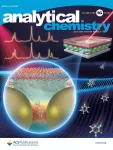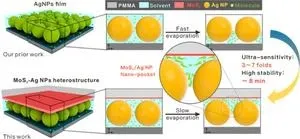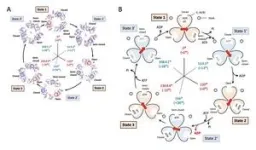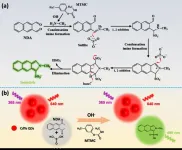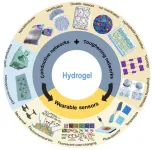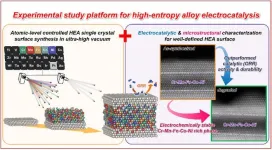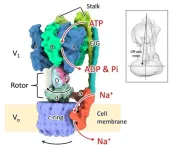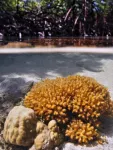(Press-News.org) The research group of YANG Liangbao at the Institute of Health and Medical Technology, Hefei Institutes of Physical Science (HFIPS), Chinese Academy of Science (CAS) has recently developed a surface-enhanced Raman spectroscopy (SERMS) method to automatically capture target molecules in AgNP/MoS2 nano-pockets, which enables highly sensitive and long-duration dynamic detection of some chemical reaction processes.
The results were published in Analytical Chemistry and selected as the front cover.
Surface-enhanced Raman spectroscopy (SERS) is a kind of molecular spectroscopy with fast, highly sensitive, and fingerprint identification properties.
"This research is based on our previous SERS studies." said Prof. YANG Liangbao, "which we have been engaging in for years."
In this experiment, the team covered a large-area monolayer nanoparticle film with a two-dimensional material called MoS2, and created an AgNP/MoS2 nano "pocket". This nano "pocket" was then placed on the target molecules to be tested. Using a multi-physics field model and finite element simulation method, the team analyzed the electric field enhancement distribution of the AgNP/MoS2 nano "pocket" structure in both solution and air, as well as the dynamic process of solution evaporation.
They found that the nano "pocket" not only possessed a high density of hotspots but also had the ability to actively capture molecules. Compared to a single-layer Ag NP film, the addition of MoS2 slowed down the evaporation of the solution, extending the window of SERS detection and further enhancing the electric field. This structure enabled high sensitivity and stability in dynamic SERS detection for up to 8 minutes.
Additionally, this structure can be utilized for detecting anti-tumor drugs and monitoring structural changes of xanthine in serum.
The related methods are expected to be more applicable to the in-situ detection of substance transformations or other chemical reaction kinetics in biological systems, according to the team.
END
Scientists suggest AgNP/MoS2 nano-pocket for surface-enhanced raman spectroscopy scattering detection
2023-07-28
ELSE PRESS RELEASES FROM THIS DATE:
Solving the climate crisis requires collaboration between natural and social scientists
2023-07-28
Now that the world has experienced its hottest day in history, it is more urgent than ever for natural and social scientists to work together to address the climate crisis and keep global temperature increases below 2°C. To this end, an international group of esteemed researchers recently published an innovative research paper that highlights the importance of integrating knowledge from natural and social sciences to inform about effective climate change policies and practice. They argue that the concept of tipping points can serve as a bridge ...
A nanoprobe developed for visual quantitative detection of pesticides
2023-07-28
Recently, Prof. JIANG Changlong and his research team at the Institute of Solid State Physics, Hefei Institutes of Physical Science (HFIPS) of Chinese Academy of Sciences (CAS), developed and synthesized two highly effective ratiometric fluorescence nanoprobes. These nanoprobes, when combined with the color recognition capabilities of smartphones, enabled the visual and quantitative detection of pesticides in food and environmental water.
The research has been published in Chemical Engineering Journal and ACS Sustainable Chemistry & Engineering.
Carbamate compounds ...
Retina cell breakthrough could help treat blindness
2023-07-28
Scientists have found a way to use nanotechnology to create a 3D ‘scaffold’ to grow cells from the retina –paving the way for potential new ways of treating a common cause of blindness.
Researchers, led by Professor Barbara Pierscionek from Anglia Ruskin University (ARU), have been working on a way to successfully grow retinal pigment epithelial (RPE) cells that stay healthy and viable for up to 150 days. RPE cells sit just outside the neural part of the retina and, when damaged, can cause vision to deteriorate.
It ...
The approaches to achieve high-performance wearable sensors with hydrogels
2023-07-28
This review is written by Dr. Weixing Song from the Department of Chemistry, Capital Normal University. The paper reviewed the toughness and conductive network of existing hydrogel sensors. It emphasized the development status of various hydrogel sensors and highlighted strategies to enhance their mechanical and electrical performance. The findings are valuable for designing components and structures of high-performance wearable hydrogel sensors.
The increasing demand for healthcare IoT devices drives the development of wearable electronics. Electronic skins possess softness, stretchability, and self-healing ...
Enhanced light sensitivity may contribute to Alzheimer's 'sundowning,' disease progression
2023-07-28
New Alzheimer’s research from UVA Health suggests that enhanced light sensitivity may contribute to “sundowning” – the worsening of symptoms late in the day – and spur sleep disruptions thought to contribute to the disease’s progression.
The new insights into the disruptions of the biological clock seen in Alzheimer’s could have important potential both for the development of treatments and for symptom management, the researchers say. For example, caregivers often struggle with the erratic sleep patterns caused by Alzheimer’s ...
Researchers reveal a powerful platform for studying high-entropy alloy electrocatalysis
2023-07-28
Introduced in 2004, high-entropy alloys (HEAs) are alloys composed of multiple principal elements in nearly equiatomic proportions. Their unique chemical composition results in a high degree of chemical disorder, i.e. entropy, and produces remarkable properties such as high strength, ductility, and strong wear-and-tear resistance even at high temperatures. Scientists have dedicated a significant amount of attention to developing novel HEAs to help improve the performance of various electrocatalyst materials.
Because they are made up of differing constituent elements, HEAs' atomic-level surface designs can be complex. But unravelling this complexity is crucial, since the surface ...
San Diego family shares recent tragedy of losing daughter to necrotizing enterocolitis, as NEC Society prepares for the NEC Symposium in San Diego
2023-07-28
San Diego, CA - The NEC Society and Cincinnati Children’s have teamed up to present the NEC Symposium, the only conference in North America dedicated to understanding and preventing necrotizing enterocolitis (NEC). NEC is a devastating intestinal disease that affects medically fragile infants in their first weeks and months of life. Every year in the United States, thousands of babies are diagnosed with NEC and at least one baby dies from NEC every day. The NEC Symposium will transform the NEC Research ...
Citizen science inspires kids to take local action
2023-07-28
North Carolina State University researchers recently found that a program designed to get Girl Scouts involved in citizen science – programs where members of the public can participate in real scientific research – not only taught girls about the process of science, but also motivated them to tackle scientific or environmental problems in their communities.
The findings demonstrate the impacts citizen science projects can have on their participants and offer lessons for other organizations on how to structure STEM-focused learning opportunities using citizen science.
“We’ve found that after participating ...
The structures of six states of a rotary sodium ion pump are revealed
2023-07-28
Six structures exhibited by the rotating sodium ion pump were reconstructed in 3D using cryo-electron microscopy. This analysis revealed that (1) the rotor exhibits non-uniform rotation behavior due to partial structural interference with the stator component, and (2) the rotor interacts with one edge of the large ion transport ring causing it to rotate. The study showed a unique molecular mechanism of the rotary sodium ion pump.
The results will be published on July 28 in Communications Biology.
“In previous single-molecule imaging ...
New research highlights risks of selective adaptation in extreme coral habitats
2023-07-28
Resilient corals, often referred to as ‘super corals’, have recently been seen as potential saviours in the face of climate change and its detrimental effects on coral reefs.
Now, a team of scientists from the University of Technology Sydney (UTS) and the University of Haifa, Israel is working to better understand these corals in order to develop strategies to protect fragile ecosystems such as the Great Barrier Reef.
UTS scientist Dr Emma Camp, co-lead researcher on the study recently published in the journal Nature Communications, says the findings have significant implications ...
